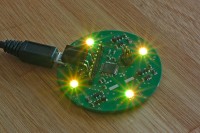Mini IR Controlled RGB LED Lamp With 5 V Input [130268-I]

This is a small RGB LED lamp which can be controlled with an infrared remote controller. Its diameter is 57 mm. It uses 4 Osram multiled LEDs which are connected in series for each color. For power supply a simple 5 V USB power supply with a micro USB connector can be used. Due to the series connection of the LEDs a boost converter is required for each color.
This is a small RGB LED lamp which can be controlled with an infrared remote controller. Its diameter is 57 mm. It uses 4 Osram multiled LEDs which are connected in series for each color. For power supply a simple 5 V USB power supply with a micro USB connector can be used. Due to the series connection of the LEDs a boost converter is required for each color. For this application many integrated circuits are on the market. In this case a NCP5007 is used, it is cheap and can drive up to 5 LEDs in series. The infrared receiver is a commonly used TSOP 31236. The evaluation of the infrared signal an the PWM control of the LED drivers is implemented in software on a Atmel Mega 88 micro controller. A controller speed of 8 MHz is sufficient, consequently there is no need for an external oscillator.
All components operate in a voltage range of about 2.7 V to 5.5 V. Thus there is no need for any additional voltage regulators in the circuit. The system can even be battery supplied without additional battery management systems, when some extra features are implemented on the controller.
The software evaluates the infrared signal and changes internal hue, saturation and value variables. Then a HSV → RGB conversion is done and the new duty cycles are applied to the LED drivers. The HSV → RGB conversion is done with 8-bit variables. Consequently, the resolution is quite coarse, also there is no human eye correction applied jet.
The PCB has the possibility to mount an external crystal oscillator and some pins for using some additional ports of the controller. However, these parts are not needed for functionality. Hence, the complete circuit consists only of 38 components respectively only approximately 11 different components.
If a light diffuser is required the circuit can be mounted in a sanded acrylic glass globe. These globes are available in handicrafts shops.
The following special components are required:
- ON SEMICONDUCTOR – NCP5007SNT1G Farnell-Nr. 1226291, 0,64 €
- OSRAM 6-lead MultiLED, rot, true green, blau Reichelt: LRTB G6TG, 1,05 €
- MOLEX - 47346-0001 - BUCHSE,MICRO USB-B,UNTEN MONT Farnell-Nr. 1568026, 1,03 €
- ATMega 88 AVR-RISC-Controller Reichelt: ATMEGA 88-20 AU, 3,05 € (possibly a cheaper version of the controller is sufficient, I don't know why I took this one...)
The RC5 codes can be programmed by shorting PIN 1 and PIN 2 on the extension port header and powering up the board. To indicate programming mode the lamp starts with the green LEDs on, instead of the blue ones. Then you have to press 30 keys of your RC5 remote controller. Every key's programming is indicated with a short blinking of the green LEDs. The preprogrammed RC5 codes in the software work with a Technisat remote controller from a satellite receiver computer card.
The following list shows the function to key mapping of the preprogrammed remote controller:
- Key 1: Brightness 1
- Key 2: Brightness 2
- Key 3: Brightness 4
- Key 4: Brightness 7
- Key 5: Brightness 11
- Key 6: Brightness 16
- Key 7: Brightness 22
- Key 8: Brightness 32
- Key 9: Brightness 252 (maximum))
- Key 0: Brightness 0
- Key Power: Brightness 0
- Key red: switch color to red
- Key green: switch color to green
- Key yellow: switch color to yellow
- Key blue: switch color to blue
- Key up: increase saturation
- Key down: decrease saturation
- Key left: decrease color hue
- Key right: increase color hue
- Key ok: toggle saturation from max to min
- Key info: do nothing
- Key menu: do nothing
- Key SFI: do nothing
- Key back (Pfeil rechts-links): do nothing
- Key Haken: do nothing
- Key TXT: do nothing
- Key STOP: do nothing
- Key HILFE: do nothing
- Key -/--: do nothing
- Key TV/Radio: do nothing



Discussion (2 comments)